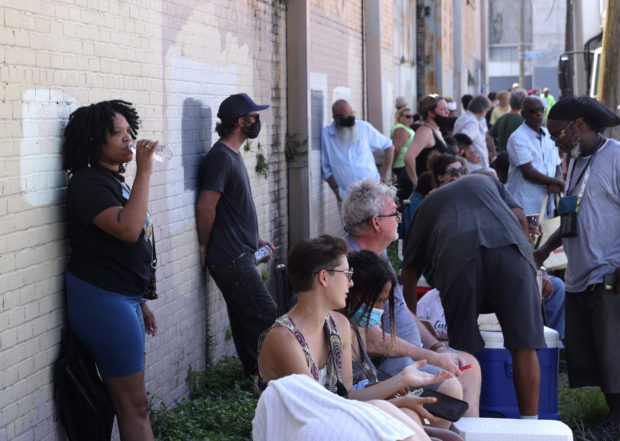Ida’s devastation shocks, fuel shortages hinder recovery

People wait in a long line in extreme heat to buy ice at Duplantier Ice Service as power continues to be out in most of the city after Hurricane Ida ripped through the state, in New Orleans, Louisiana, U.S., September 1, 2021. REUTERS
HOUMA, Louisiana — Storm damage from Ida astounded officials on Wednesday three days after the powerful hurricane pounded southern Louisiana, as reconnaissance flights revealed entire communities devastated by winds and floods.
With President Joe Biden due to survey the destruction for himself on Friday, Louisiana Governor John Bel Edwards issued a plea for emergency supplies to assist a million homes and businesses without power, as well as 600,000 people without water.
The number of fatalities rose to six on Wednesday following the confirmed deaths of two electricity workers in Alabama who had been repairing the power grid, according to an executive with utilities provider Pike Electric.
Thousands more were in misery, with countless homes destroyed and towns flooded, evoking memories of Hurricane Katrina, which killed some 1,800 and nearly destroyed New Orleans 16 years ago.
The southern coastline where Ida came ashore as a Category 4 hurricane on Sunday was hardest hit, with the barrier island town of Grand Isle declared uninhabitable by the parish president after it was covered by three feet (one meter) of sand.
Article continues after this advertisement“I had no idea how devastating the storm was,” Jefferson Parish President Cynthia Lee Sheng told a news conference after flying over Grand Isle and the rest of Ida’s path on Wednesday along with U.S. Representative Steve Scalise, whose district took the brunt of the storm.
Article continues after this advertisement“We are a broken community right now,” Lee Sheng said. “It looks like matchsticks, like a little pile of matchsticks that you’re flying over.”
Virtually every structure on the island of 740 people sustained damage and about 40% were destroyed, she said.
Scalise reported seeing major marine vessels and dry docks picked up and moved. “It tells you just what kind of strong winds hit for sustained hours at a time,” he added.
In nearby Terrebonne Parish, south of New Orleans, the main street of Houma was littered with metal and wood that had peeled off buildings. A tattoo parlor’s front door was destroyed and glass was strewn all along the road.
“Never again,” said Danna Schwab, 56, of her decision to ride out the storm in Houma and the hours she and her daughter spent pushing against a window to prevent it from blowing in. “It was so scary.”
‘All the help we can get’
Federal and local officials said their immediate focus was on getting water, food and ice to the most vulnerable, especially the elderly, to cope with elevated temperatures. The weather service has issued warnings for parts of Louisiana and Mississippi, with a heat index rising above 100 degrees Fahrenheit (38 degrees Celsius).
A long line formed outside a civic center in Houma where people waited in cars to get bottled water, ice and tarps from police officers and volunteers.
Loretta Williams, 67, teared up as she described the destruction of her mobile home and the back windshield of her car, which she had covered with a black tarp.
“All I’ve been doing lately is crying. I worked so hard for what I had and it all just disappeared overnight,” Williams said.
Governor Edwards told the news conference he was pressing the U.S. government for help securing bulk fuel supplies while refineries remained offline.
The crucial offshore oil industry hub of Port Fourchon remained cut off from supply boats, fuel and air ferry services. Dozens of oil and gas companies operate in the U.S. Gulf of Mexico, which supplies 1.7 million barrels per day, or about 16% of the nation’s oil production.
“The state of Louisiana provides fuel for the rest of the country. And now we need the rest of the country to give up a little bit of their fuel to come back to Louisiana,” Edwards said.
Asked what else he might ask Biden for during his visit on Friday, the governor said, “Quite frankly, the list is going to be very, very long … We need all the help we can get.”
Although weakened, Ida’s remnants combined with another front on Wednesday to bring heavy rains across a wide swath of the Northeast.
Tornadoes spawned by the storm ripped through parts of Pennsylvania and New Jersey, images on social media showed. At least nine homes were destroyed in Mullica Hill, New Jersey, Philadelphia’s NBC10 television station reported.
New Jersey’s Newark Liberty Airport announced flights were suspended.
New York City also experienced flooding, with social media images showing water gushing over subway platforms and trains.
Subway service was “extremely limited” due to the flooding, the Metropolitan Transit Authority said.
“If you’re on a train that’s stuck, stay on that train; the safest place to be is on the train unless you hear otherwise from the conductor,” the MTA said on Twitter.